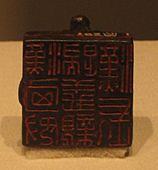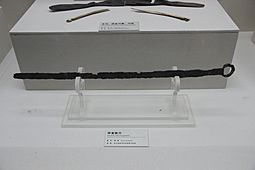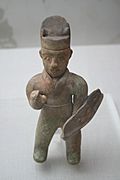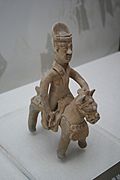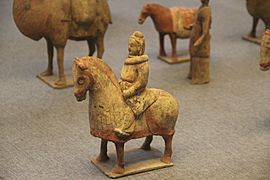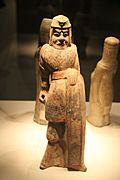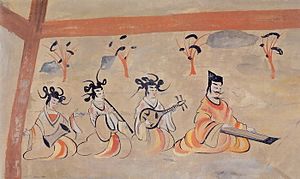Sixteen Kingdoms facts for kids
Quick facts for kids Sixteen Kingdoms |
|||||||||||||
|---|---|---|---|---|---|---|---|---|---|---|---|---|---|
| Traditional Chinese | 十六國 | ||||||||||||
| Simplified Chinese | 十六国 | ||||||||||||
|
|||||||||||||
The Sixteen Kingdoms (simplified Chinese: 十六国; traditional Chinese: 十六國; pinyin: Shíliù Guó) was a time in Chinese history from the years 304 to 439 AD. During this period, northern China was split into many small, short-lived states. Most of these states were started by groups called the "Five Barbarians". These were non-Han peoples who had moved to northern and western China over the years.
In the early 4th century, these groups started rebellions and invasions against the Western Jin dynasty. Some states were also founded by Han Chinese people. All these states, whether ruled by Xiongnu, Xianbei, Di, Jie, Qiang, or Han, used Chinese-style names for their dynasties.
These states often fought each other and the Eastern Jin dynasty. The Eastern Jin took over from the Western Jin in 317 and ruled southern China. The Sixteen Kingdoms period ended in 439 when northern China was united by the Northern Wei dynasty. This dynasty was started by the Xianbei Tuoba clan. This happened 19 years after the Eastern Jin dynasty ended in 420. After the Northern Wei united the north, the Northern and Southern dynasties era of Chinese history began.
The name "Sixteen Kingdoms" was first used by a historian named Cui Hong in the 6th century. It refers to 16 specific states, but many other kingdoms also existed at that time.
Historians sometimes call this period the "Sixteen Kingdoms of the Five Barbarians". This is because non-Han groups played a very active role. Even some states founded by Han Chinese people had close ties with these ethnic groups. For example, the father of Ran Min, who started the Ran Wei state, was adopted by a ruling family of the Later Zhao.
Because of constant fighting and unstable governments, most of these kingdoms did not last long. For a short time, from 376 to 383, the Former Qin kingdom united northern China. But this ended when the Eastern Jin defeated them badly at the Battle of Fei River. After this defeat, the Former Qin broke apart, and northern China became even more divided.
History of the Kingdoms
Why the Kingdoms Started
From the late Eastern Han dynasty to the early Western Jin dynasty, many non-Han peoples moved into northern China. Some, like the Xiongnu and Xianbei, were nomads from the northern grasslands. Others, like the Di and Qiang, were farmers and herders from western China.
These migrants lived among the Han Chinese. Many worked as farm laborers. Some even became officials or soldiers. However, they often faced unfair treatment and kept their own tribal ways. The Han dynasty had moved some Xiongnu groups into China after wars. Other groups, like the Qiang, were also settled inside China.
The War of the Eight Princes (291–306) greatly weakened the Jin government. This war killed many people and forced millions to move. Rebellions against high taxes also broke out. The many tribal groups in the north, who had been forced to join the army, used this chaos to gain power.
In 304, Li Xiong, a Di leader, started a successful rebellion in Sichuan. He founded the Cheng Han kingdom. This was the beginning of independent kingdoms forming as the Jin dynasty's power fell apart. Most of these new kingdoms were started by non-Chinese tribal leaders who adopted Chinese names for their rule.
Jin Dynasty's View
The Eastern Jin dynasty, which ruled southern China, always saw itself as the main ruler. It refused to treat any of the northern kingdoms as equals. For example, when the Later Zhao kingdom sent a diplomatic group to the south to ask for equal relations, the Eastern Jin burned their gifts and sent them away. Some northern kingdoms, like Former Yan, did agree to recognize the Eastern Jin as their higher authority.
Western Jin Falls to Former Zhao
Jin princes often hired non-Chinese tribes for their armies. In 304, Liu Yuan, a Xiongnu leader, declared his independence in Shanxi. He said his new state was a successor to the Han Dynasty. Historians call his kingdom the Han Zhao or Former Zhao.
After Liu Yuan died in 310, his son Liu Cong took the throne. In 311, Liu Cong captured the Jin capital, Luoyang, and the Jin Emperor. In 316, Liu Cong's uncle Liu Yao captured Chang'an (modern Xi'an), ending the Western Jin Dynasty.
Sima Rui, a Jin prince, moved south and continued the dynasty as the Eastern Jin from Jiankang (modern Nanjing). As Jin power collapsed in the north, other leaders also declared independence. In 313, Zhang Gui, a Chinese governor, founded the Former Liang in modern Gansu. In 315, Tuoba Yilu, a Xianbei leader, founded the Dai in modern Inner Mongolia.
Shi Le and the Later Zhao
After Liu Cong died, his kingdom split. Shi Le, a Jie general, started his own Zhao Kingdom in 319, known as the Later Zhao. In 328, he conquered Liu Yao's Former Zhao. Shi Le ruled much of northern China. After his death, his sons fought over who would rule next. In 350, General Ran Min, a Han Chinese, took the throne and started the Ran Wei kingdom. Ran Min favored Han Chinese and killed many Jie people. He was defeated and killed in 352 by the Murong Xianbei from Liaodong.
In 337, Murong Huang founded the Former Yan in Liaodong. By 356, it had grown to cover much of Hebei, Henan, and Shandong. For a while, Former Yan and Former Qin competed for power in northern China.
Former Qin and Northern China's Brief Unity
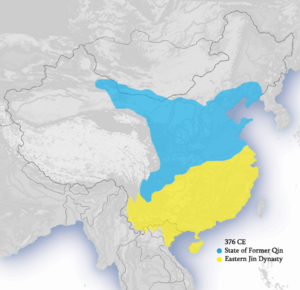
The Former Qin was founded in 351 by Fu Jian (317–355), a Di general. His nephew, Fu Jian (337–385), later took control. With the help of his advisor Wang Meng, the Former Qin grew strong very quickly. From 370 to 376, the Former Qin conquered the Former Yan, Dai, and Former Liang, uniting all of northern China.
Fu Jian also captured Sichuan from the Eastern Jin. He wanted to conquer the rest of southern China. Wang Meng disagreed, saying they needed to strengthen their control over the different groups in northern China first. However, other generals supported the idea. In 383, after Wang Meng died, Fu Jian launched a huge invasion of southern China. But his army was badly defeated at the Battle of Feishui by a much smaller Eastern Jin force.
Northern China Breaks Apart Again

After the Battle of Feishui, the Former Qin's power quickly fell apart. Many new states appeared in the north. In 384, Murong Chui founded the Later Yan in Hebei. Other Murong royals founded the Western Yan in Shanxi. Yao Chang founded the Later Qin in eastern Gansu. Fu Jian was killed by Yao Chang.
The Former Qin kingdom survived by moving to Gansu and then Qinghai. In 385, Qifu Guoren, a Xianbei leader, founded the Western Qin. In 386, Lü Guang, a Di general, founded the Later Liang in western Gansu. Tuoba Gui brought back the Dai kingdom, renaming it the Northern Wei. For nine years, as many as seven kingdoms existed at the same time.
The Later Qin conquered the Former Qin in 394, the Western Qin in 400, and Later Liang in 403. It controlled much of Shaanxi, Gansu, and Ningxia. But in 407, Helian Bobo, a Xiongnu leader, rebelled and founded the Xia in northern Shaanxi. The Western Qin was also revived. In 416, the Eastern Jin, led by General Liu Yu, attacked north. They captured Luoyang and Chang'an, ending the Later Qin. However, the Eastern Jin could not hold these cities. Liu Yu returned south to take the Jin throne, and the Xia kingdom quickly took Chang'an.
Later Liang Splits
In western Gansu, the Later Liang split into the Northern Liang and Southern Liang in 397. The Southern Liang was founded by Tufa Wugu, a Xianbei. The Northern Liang was founded by Duan Ye, a Chinese man, with the help of Juqu Mengxun, a Xiongnu, who then took control in 401.
In 405, Li Gao, a Chinese commander, broke away from Northern Liang and founded the short-lived Western Liang. The Western Liang was later taken back by the Northern Liang in 421. Li Gao's family would later start the Tang Dynasty in the 7th century. The Southern Liang was conquered by the Western Qin in 414. The Northern Liang lasted until 439, when it surrendered to the Northern Wei.
Later Yan Splits
The Later Yan conquered the Zhai Wei in 392 and the Western Yan in 394. But it lost many battles to the Northern Wei. In 397, the Northern Wei captured Hebei, splitting the Later Yan into two. Murong Bao moved the Later Yan capital north. But Murong De refused to move and founded the Southern Yan in Henan and Shandong. The Southern Yan was ended by the Eastern Jin in 410.
The Later Yan lasted until 407. General Feng Ba killed the emperor and put Gao Yun in power. Gao Yun is seen as either the last emperor of Later Yan or the first of the Northern Yan. In 409, Feng Ba killed Gao Yun and took control of the Northern Yan.
Eastern Jin Tries to Take Back the North
During its 100-year rule in southern China, the Eastern Jin Dynasty tried several times to get the North back. They had some success but never fully succeeded. In 313, Emperor Yuan gave General Zu Ti a small army for a northern expedition. Zu Ti managed to take back a large part of Henan and defeated the Later Zhao forces.
Jin Emperors were often worried that successful generals would become too powerful. So, Emperor Yuan did not give Zu Ti a larger army. Zu Ti died of illness, and his army was called back. Shi Le then took back Henan.
In 347, Jin general Huan Wen invaded Sichuan and ended the Cheng Han kingdom. He then led more attacks against northern kingdoms. He briefly took Chang'an in 354 and Luoyang in 356. In 369, he led a large force into Hebei but was defeated by the Former Yan. In 383, the Eastern Jin took back Henan after defeating the Former Qin at the Battle of Feishui. But they lost this land again when the northern kingdoms grew stronger.
Huan Wen wanted to seize power himself. His son, Huan Xuan, briefly took the throne in 403 but was defeated by General Liu Yu.
Liu Yu also used northern expeditions to gain power. In 409–410, he led Jin forces to defeat and destroy the Southern Yan. In 416, he took advantage of the Later Qin ruler's death. He invaded Henan, captured Luoyang, and then seized Chang'an. The last Later Qin ruler surrendered and was executed. With the Later Qin gone, some smaller states in the northwest recognized Eastern Jin rule. But Liu Yu went back south to plan his takeover of the Jin throne. The Xia forces then took Chang'an. In 420, Liu Yu forced the Jin Emperor to step down and declared himself emperor of the Liu Song Dynasty. He died in 423. The Liu Song dynasty ruled southern China until 479.
Northern Wei Unites Northern China
The Tuoba Xianbei people originally lived in Inner Mongolia. In 315, their chief, Tuoba Yilu, was recognized as the Prince of Dai by the Jin Emperor. In 338, Tuoba Shiyijian officially declared Dai's independence. In 376, the Former Qin attacked them, and Tuoba Shiyijian was killed.
In 386, Tuoba Shiyijian's grandson, Tuoba Gui, brought the kingdom back. He renamed it Wei, known as the Northern Wei. Tuoba Gui expanded his territory, capturing Shanxi and Hebei from the Former Yan and Henan from the Liu Song dynasty. In 398, he moved the capital to Pingcheng (modern Datong) and declared himself Emperor.
In 423, Tuoba Gui's grandson, Tuoba Tao, became Emperor Taiwu. He began the mission to unite the North. Under his rule, the Northern Wei defeated the Rouran nomads to the north. They also began conquering Shaanxi, Ningxia, and Gansu. In 427, he captured the Xia capital, Tongwancheng.
The Xia, under Helian Ding, moved to Pingliang. They conquered the Western Qin in 431. Helian Ding tried to ally with the Liu Song dynasty but was pushed further west by the Northern Wei. He was captured by the Tuyuhun nomads and executed by the Northern Wei. In 436, Emperor Taiwu led an attack against the Northern Yan. The Northern Yan ruler fled to Goguryeo, where he was killed. The last ruler of the Northern Liang surrendered in 439. This completed the Northern Wei's unification of northern China and marked the end of the Sixteen Kingdoms period. The Tuoba people eventually adopted Chinese customs and changed their name to Yuan. They ruled northern China until the 550s.
Chinese history then entered the Northern and Southern Dynasties period. During this time, different dynasties ruled in the North and South until the Sui Dynasty united the country in 589.
Maps
Chronology
| Chronology of the Sixteen Kingdoms with Ethnicity of Founders | ||||||||||||
| Xianbei Xiongnu Jie Di Qiang Dingling Han Chinese | ||||||||||||
| 303 | Jin Dynasty's rule over northern China and Sichuan begins to break down in 304 | WESTERN JIN DYNASTY* 266-317 |
||||||||||
| 304 | Cheng Han 304-47 |
Former Zhao 304-29 |
||||||||||
| 314 | Former Liang 314-76 |
|||||||||||
| 315 | Dai* 315-76 |
|||||||||||
| 317 | ||||||||||||
| 318 | EASTERN JIN DYNASTY* 318-420 |
|||||||||||
| 319 | Later Zhao 319-51 |
|||||||||||
| 329 | ||||||||||||
| 330 | ||||||||||||
| 337 | Former Yan 337-70 |
|||||||||||
| 347 | ||||||||||||
| 350 | Ran Wei* 350-52 |
|||||||||||
| 351 | Former Qin 351-94 |
|||||||||||
| 352 | ||||||||||||
| 353 | ||||||||||||
| 370 | ||||||||||||
| 376 | ||||||||||||
| 377 | From 376 to 383, Former Qin briefly unites northern China | |||||||||||
| 384 | NORTHERN WEI DYNASTY* 386-534 |
Later Qin 384-421 |
Western Yan* 384-94 |
Later Yan 384-409 |
||||||||
| 385 | Western Qin 385-400 |
|||||||||||
| 388 | Zhai Wei* 388-92 |
|||||||||||
| 389 | Later Liang 389-403 |
|||||||||||
| 392 | ||||||||||||
| 394 | ||||||||||||
| 397 | Southern Liang 397-414 |
Northern Liang 397-439 |
||||||||||
| 398 | Southern Yan 398-410 |
|||||||||||
| 400 | Western Liang 400-21 |
|||||||||||
| 403 | ||||||||||||
| 404 | ||||||||||||
| 407 | Xia 407-31 |
|||||||||||
| 409 | Western Qin resurrected 409-31 |
Northern Yan 409-36 |
||||||||||
| 410 | ||||||||||||
| 414 | ||||||||||||
| 417 | ||||||||||||
| 420 | LIU SONG DYNASTY* 420-79 |
|||||||||||
| 421 | ||||||||||||
| 431 | ||||||||||||
| 436 | ||||||||||||
| 439 | ||||||||||||
| 440 | In 439, the Northern Wei reunites northern China | |||||||||||
| asterisk (*) denotes kingdoms not counted among the sixteen in the Spring and Autumn Annals of the Sixteen Kingdoms | ||||||||||||
Other Groups Involved
The Goguryeo kingdom was a strong state in northern Korea and parts of northeastern China. The Murong Xianbei attacked Goguryeo many times. In 342, Prince Murong Huang of Former Yan captured the Goguryeo capital. Later, under King Gwanggaeto the Great, Goguryeo fought against the Later Yan and gained land near the Liao River. When the Northern Yan kingdom was destroyed by the Northern Wei, its king fled to Goguryeo for safety.
Other groups like the Yuwen Xianbei and the Khitan also grew stronger. They later declared loyalty to the Northern Yan, and then to the Northern Wei. This meant the Northern Wei controlled a large area, including the Mongolian Plateau.
In the Western Regions (modern Xinjiang), there were kingdoms like Shanshan and Yutian. These kingdoms were often controlled by the various Liang kingdoms during this period. The Former Liang set up local governments there. Later, the Former Qin ruler Fu Jian sent a general to the Western Regions. After Qin fell, this general founded the Northern Liang, and the western kingdoms became part of it or its vassals.
Religion During This Time
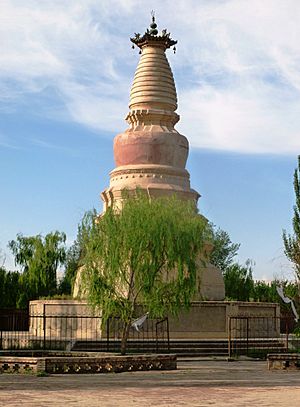
Several rulers of the northern kingdoms supported Buddhism. This religion spread across northern China during the Sixteen Kingdoms period and became very popular later.
The Former Qin ruler Fu Jian was a big supporter of Buddhist studies. He invited a monk named Dao An to his capital to organize Buddhist scriptures. When the teachings of the famous monk Kumārajīva reached the capital, Dao An advised Fu Jian to invite him. In 382, Fu Jian sent a general to bring Kumārajīva to China.
However, the Former Qin kingdom fell apart after the Battle of Feishui in 383. Kumārajīva was held captive for 18 years. In 401, the Later Qin ruler conquered the area where Kumārajīva was. Kumārajīva was then able to settle in Chang'an. He became one of the most important translators of Buddhist texts into Chinese.
The earliest cave temples in the Mogao Caves of Dunhuang were carved during the Former Qin. Work on the Maijishan Grottoes started during the Later Qin. The Bingling Grottoes began during the Western Qin. Many other cave temples were built under the Northern Liang.
See also
 In Spanish: Dieciséis Reinos para niños
In Spanish: Dieciséis Reinos para niños
- Battle of Fei River
- Ethnic groups in Chinese history
- Family trees of the rulers of the Sixteen Kingdoms
- Five Barbarians
- Invasion and rebellion of the Five Barbarians
- Sinicization



